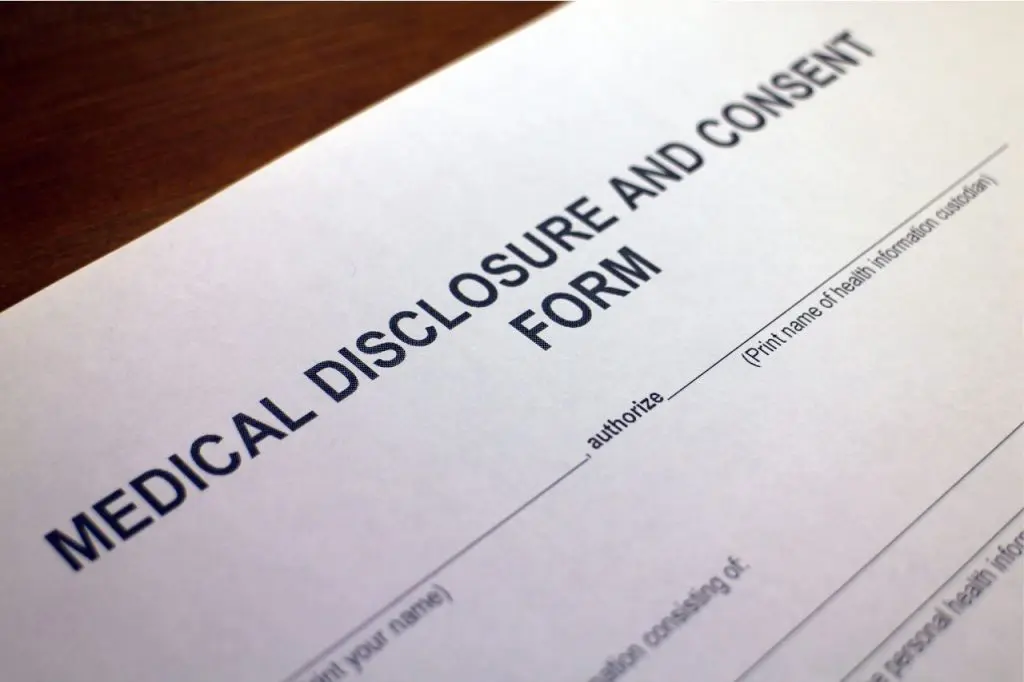Informed consent in healthcare involves explaining the risks and benefits of a procedure. Before a patient can consent, the doctor must describe what will happen during and after a medical procedure.
Part of this essential process is signing informed consent forms. For example, a patient must sign forms to indicate that they are undergoing surgery of their own free will.
Here, we’ll go over everything you need to know about informed consent forms, including their importance and essential elements.
Table of Contents
- What Is Informed Consent?
- What Is the Purpose of Informed Consent?
- 3 Key Elements of an Informed Consent
- Informed Consent Forms: Sample Statements
- 3 Types of Informed Consent

What Is Informed Consent?
Informed consent refers to a person’s agreement to do something after being given all the facts. For example, you must sign a consent form before participating in any research study of certain diseases and possible treatments. It should include information about:
- the nature of the research
- the risks and benefits of participating
- the right of participants to withdraw from the study at any time
the contact information for the research team.
Aside from medical research, informed consent plays a vital role in healthcare. Patients must be allowed to make well-considered decisions about medical interventions. Informed consent comes into play when healthcare professionals and their clients collaborate to make decisions about a patient’s care.
Healthcare practitioners must give the patients enough information on the proposed treatment or surgery before it is carried out. They should spell out the risks, benefits, and alternatives in detail. Patients must show that they fully understand what is being proposed before consenting to undergo the treatment.
What Is the Purpose of Informed Consent?
The purpose of informed consent is to ensure that patients understand the risks and benefits of a treatment, medical procedure, or participation in a study. This way, they can make an informed decision about whether or not they will proceed.
If the practitioner does not get informed consent and something happens to the participant, the latter can file a malpractice suit.
However, there are exceptions to the rule, especially in an emergency. Sometimes, a patient can’t give consent because they are unconscious or otherwise incapacitated. When faced with a life-or-death situation, the practitioner may act in good faith and save the patient.
The Good Samaritan law, which protects healthcare professionals from civil liability, may override the use of informed consent. This law is applicable in some states and under specific situations such as a motorcycle accident or car crash. It may also apply in settings outside a clinic or hospital, such as airplanes and sporting events, when the healthcare professional must exercise the call of duty.
3 Key Elements of Informed Consent
Informed consent has the following attributes:
1. Disclosure
It refers to the sharing of information between healthcare providers and patients. Healthcare providers must disclose all relevant information about the proposed treatment. Explanations should be in clear and concise language that could be understood by someone with little or no medical knowledge.
2. Comprehension
It refers to the patient’s understanding of the information disclosed by the healthcare provider. Patients must be able to understand the information to make an informed decision. Their comprehension or capacity to understand is assessed on a case-by-case basis. Factors impacting a person’s capacity include age, mental status, alcohol or drug intake, and cognitive impairment.
3. Voluntariness
It refers to the patient’s ability to make a free and uncoerced decision about their care. Patients must be allowed to make decisions without force or pressure from anyone, especially healthcare providers. They must also be given enough time to weigh the pros and cons before making a decision.

Informed Consent Forms: Sample Statements
An informed consent form should disclose all relevant information about the proposed treatment, including potential risks and side effects. It should be written in clear and understandable language. Lastly, it should be signed by the patient or their legal guardian.
Here are some statements that are included in consent forms:
Disclosure statement
The following is an example of a disclosure statement that a healthcare provider might use in a consent form:
“I am required to inform you that there are risks inherent in any medical treatment. In this particular procedure, the risks may include, but are not limited to, infection, bleeding, and/or visibility of scars. As with any medical procedure, there is also a risk that the results may not be what you expected.”
Voluntariness statement
The form should also include a section on voluntariness, confirming that the patient is not being forced into undergoing a medical procedure or treatment.
The patient has the right to know about their diagnosis, prognosis, and treatment options. This statement below reminds patients that they are under no obligation to undergo any treatment or procedure and can withdraw their consent anytime:
“I understand that I am free to refuse this procedure or to withdraw my consent at any time before or during the procedure. I further understand that my refusal or withdrawal of consent will not result in any penalty or loss of benefits to which I am otherwise entitled.”
By reading and signing this statement, the patient is reaffirming their right to make an autonomous decision about their care.
Capacity statement of a practitioner and patient
The form should include a statement on capacity, confirming that the patient is of sound mind and able to understand the information contained in the form. On another note, there must also be a confirmation that the medical practitioner has a capacity and knowledge to go through the procedure.
From the patient:
This statement confirms that the patient has the ability to understand the information contained in the form. It also shows that they can make an informed decision about whether to proceed with the procedure.
“I hereby confirm that I am of sound mind and able to understand the information contained in this form. I have been given sufficient time to consider all of the risks and benefits of the procedure, and I am willing to proceed with it.”
From the practitioner:
A statement of capacity informs the patient that the doctor is licensed and has hospital privileges. The physician’s credentials should be easily accessible to the patient so that they can make an informed decision about their care.
For instance, a surgeon may write that they are able to “perform the surgery with minimal risk of complications.”
Keep in mind that consent forms will vary depending on the specific procedure being performed.
3 Types of Informed Consent
There are three types of informed consent: oral, written, and online form. Each has its own benefits and drawbacks, so choosing the right type is important when you need to agree on a specific procedure.
Oral consent
It is the simplest form of informed consent. You simply explain the nature of the procedure and ask the patient if they’re willing to go ahead with it. The main advantage of oral consent is that it’s quick and easy to obtain. However, it can be difficult to document properly, and patients may not remember all the details later on.
Written consent forms
They are more detailed than oral consent forms. They explain the procedure in greater depth and list any risks and side effects. This can make them more time-consuming to fill out, but it also means there’s a clear record of what was discussed. The main disadvantage of written consent forms is that they can be daunting for patients to read through.
Online consent forms
Informed consent forms are becoming increasingly popular as more people conduct business online. They have the same benefits as written consent forms, but they’re usually shorter and easier to fill out. The main disadvantage of online consent forms is that patients may not read them carefully before agreeing to them.
Do you want to integrate online consent forms in your clinic or hospital? Look no further, you can create and manage HIPAA compliant forms with the Fill app. You don’t have to write a form from scratch. Simply choose a template and tailor the information to your needs.
Try it for free and see how efficient it is to get informed patient consent using Fill.




